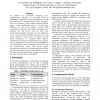Free Online Productivity Tools
i2Speak
i2Symbol
i2OCR
iTex2Img
iWeb2Print
iWeb2Shot
i2Type
iPdf2Split
iPdf2Merge
i2Bopomofo
i2Arabic
i2Style
i2Image
i2PDF
iLatex2Rtf
Sci2ools
ISMAR
2002
IEEE
2002
IEEE
Communication Behaviors of Co-Located Users in Collaborative AR Interfaces
We conducted two experiments comparing users’ communication behaviors of co-located users in collaborative augmented reality (AR) interfaces. In the first experiment, we compared optical, stereo- and monovideo, and immersive head mounted displays (HMDs) using a target identification task. It was found that differences in real world visibility severely affect communication behaviors. The optical see-through case produced the best results with the least extra communication needed. Generally, the more difficult it was to use non-verbal communication cues, the more people resorted to speech cues to compensate. In the second experiment, we compared three different combinations of task and communication spaces using a 2D icon designing task with optical see-through HMDs. It was found that the spatial relationship between the task and communication spaces also severely affects communication behaviors. Placing the task space between the subjects produced the most active behaviors in terms o...
Affect Communication Behaviors | Augmented Reality | Communication Behaviors | Communication Spaces | ISMAR 2002 |
| Added | 15 Jul 2010 |
| Updated | 15 Jul 2010 |
| Type | Conference |
| Year | 2002 |
| Where | ISMAR |
| Authors | Kiyoshi Kiyokawa, Mark Billinghurst, Sean Hayes, Anoop Gupta, Yuki Sannohe, Hirokazu Kato |
Comments (0)

